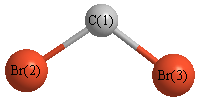Jump to
S2C1
Energy calculated at LSDA/6-31G(2df,p)
| | hartrees |
|---|
| Energy at 0K | -5175.917669 |
| Energy at 298.15K | -5175.922733 |
| HF Energy | -5175.917669 |
| Nuclear repulsion energy | 332.868953 |
The energy at 298.15K was derived from the energy at 0K
and an integrated heat capacity that used the calculated vibrational frequencies.
Geometric Data calculated at LSDA/6-31G(2df,p)
Point Group is C2v
Cartesians (Å)
| Atom |
x (Å) |
y (Å) |
z (Å) |
|---|
| C1 |
0.000 |
0.000 |
0.989 |
| Br2 |
0.000 |
1.519 |
-0.085 |
| Br3 |
0.000 |
-1.519 |
-0.085 |
Atom - Atom Distances (Å)
| |
C1 |
Br2 |
Br3 |
| C1 | | 1.8601 | 1.8601 |
Br2 | 1.8601 | | 3.0379 | Br3 | 1.8601 | 3.0379 | |
 More geometry information
More geometry information
Calculated Bond Angles
| atom1 |
atom2 |
atom3 |
angle |
|
atom1 |
atom2 |
atom3 |
angle |
| Br2 |
C1 |
Br3 |
109.496 |
|
Electronic energy levels
Charges, Dipole, Quadrupole and Polarizability
Charges from optimized geometry at LSDA/6-31G(2df,p)
Charges (e)
| Number |
Element |
Mulliken |
CHELPG |
AIM |
ESP |
| 1 |
C |
-0.235 |
|
|
|
| 2 |
Br |
0.117 |
|
|
|
| 3 |
Br |
0.117 |
|
|
|
Electric dipole moments
Electric dipole components in Debye
(What's a Debye? See section
VII.A.3)
| |
x |
y |
z |
Total |
| |
0.000 |
0.000 |
-1.171 |
1.171 |
| CHELPG |
|
|
|
|
| AIM |
|
|
|
|
| ESP |
|
|
|
|
Electric Quadrupole moment
Quadrupole components in D Å
| Primitive |
|---|
| | x | y | z |
|---|
| x |
-40.359 |
0.000 |
0.000 |
| y |
0.000 |
-38.711 |
0.000 |
| z |
0.000 |
0.000 |
-43.819 |
|
| Traceless |
|---|
| | x | y | z |
|---|
| x |
0.907 |
0.000 |
0.000 |
| y |
0.000 |
3.377 |
0.000 |
| z |
0.000 |
0.000 |
-4.284 |
|
| Polar |
|---|
| 3z2-r2 | -8.569 |
|---|
| x2-y2 | -1.647 |
|---|
| xy | 0.000 |
|---|
| xz | 0.000 |
|---|
| yz | 0.000 |
|---|
|
Polarizabilities
Components of the polarizability tensor.
Units are
Å
3 (Angstrom cubed)
Change units.
| |
x |
y |
z |
| x |
5.055 |
0.000 |
0.000 |
| y |
0.000 |
11.805 |
0.000 |
| z |
0.000 |
0.000 |
6.247 |
<r2> (average value of r
2) Å
2
| <r2> |
193.464 |
| (<r2>)1/2 |
13.909 |
Jump to
S1C1
Energy calculated at LSDA/6-31G(2df,p)
| | hartrees |
|---|
| Energy at 0K | -5175.890331 |
| Energy at 298.15K | -5175.895406 |
| HF Energy | -5175.890331 |
| Nuclear repulsion energy | 323.705013 |
The energy at 298.15K was derived from the energy at 0K
and an integrated heat capacity that used the calculated vibrational frequencies.
Geometric Data calculated at LSDA/6-31G(2df,p)
Point Group is C2v
Cartesians (Å)
| Atom |
x (Å) |
y (Å) |
z (Å) |
|---|
| C1 |
0.000 |
0.000 |
0.691 |
| Br2 |
0.000 |
1.625 |
-0.059 |
| Br3 |
0.000 |
-1.625 |
-0.059 |
Atom - Atom Distances (Å)
| |
C1 |
Br2 |
Br3 |
| C1 | | 1.7896 | 1.7896 |
Br2 | 1.7896 | | 3.2491 | Br3 | 1.7896 | 3.2491 | |
 More geometry information
More geometry information
Electronic energy levels
Charges, Dipole, Quadrupole and Polarizability
Charges from optimized geometry at LSDA/6-31G(2df,p)
Charges (e)
| Number |
Element |
Mulliken |
CHELPG |
AIM |
ESP |
| 1 |
C |
-0.237 |
|
|
|
| 2 |
Br |
0.118 |
|
|
|
| 3 |
Br |
0.118 |
|
|
|
Electric dipole moments
Electric dipole components in Debye
(What's a Debye? See section
VII.A.3)
| |
x |
y |
z |
Total |
| |
0.000 |
0.000 |
-0.586 |
0.586 |
| CHELPG |
|
|
|
|
| AIM |
|
|
|
|
| ESP |
|
|
|
|
Electric Quadrupole moment
Quadrupole components in D Å
| Primitive |
|---|
| | x | y | z |
|---|
| x |
-41.771 |
0.000 |
0.000 |
| y |
0.000 |
-37.687 |
0.000 |
| z |
0.000 |
0.000 |
-41.327 |
|
| Traceless |
|---|
| | x | y | z |
|---|
| x |
-2.264 |
0.000 |
0.000 |
| y |
0.000 |
3.862 |
0.000 |
| z |
0.000 |
0.000 |
-1.598 |
|
| Polar |
|---|
| 3z2-r2 | -3.196 |
|---|
| x2-y2 | -4.084 |
|---|
| xy | 0.000 |
|---|
| xz | 0.000 |
|---|
| yz | 0.000 |
|---|
|
Polarizabilities
Components of the polarizability tensor.
Units are
Å
3 (Angstrom cubed)
Change units.
| |
x |
y |
z |
| x |
5.038 |
0.000 |
0.000 |
| y |
0.000 |
11.624 |
0.000 |
| z |
0.000 |
0.000 |
5.598 |
<r2> (average value of r
2) Å
2
| <r2> |
213.002 |
| (<r2>)1/2 |
14.595 |
